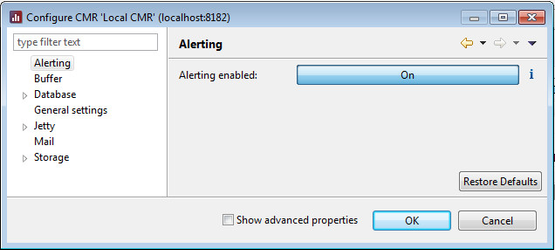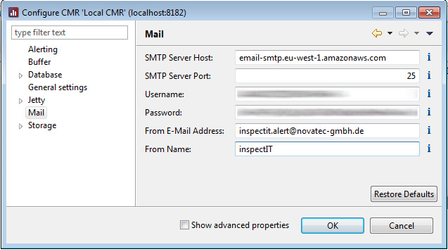Alerting configuration
Updating the CMR properties
Please read the general information on updating the CMR properties first on the CMR Configuration page.
The Central Management Repository is able to check whether the collected data is below or above a certain threshold. Based on this, notification e-mails can be send to inform about the threshold violation.
The alerting works only if the time series database is used for the persisting long term data. See Setup Monitoring and Long-term Data Persistence Configuration pages first.
Enable the Alerting
The alerting feature can be turned on and off in the configuration dialog of the corresponding CMR. To turn it on/off navigate to Alerting and turn on/off the option "Alerting enabled". If this option is "On", the specified alert will be checked (to specified alerts and thresholds, see Setup Alerts and Thresholds for more details). In order to send notification e-mails which inform about a threshold violation, the CMR's Mail settings have to be configured.
Configure the e-Mail Settings
The CMR uses a SMTP server to send e-mails. This requires that a SMTP server is specified in the configuration which can be configured in the Mail section of the configuration dialog. The options are described in more detail below.
| Configuration Property | Description |
|---|---|
| SMTP Server Host | The host name or IP of the SMTP server. |
| SMTP Server Port | The port of the SMTP server. |
| Username | The username used for authentication on the SMTP server. |
| Password | The password used for authentication on the SMTP server. |
| From E-Mail Address | The e-mail address used in the notification e-mail as the sender's address. |
| From Name | The name used in the notification e-mail as the sender's name. |
Customizing Notification e-Mail Templates
The notification e-mails which will be send when an threshold has been violated can be customized. The templates which form the basis for them are located in the CMR's templates directory.
Each template is available as a HTML and textual representation. Furthermore, there are multiple templates which are used in different situations. See the following table for more details.
| HTML Template | Text Template | Used when.. |
|---|---|---|
| alert-open.html | alert-open.txt | ..an alert is started |
| alert-bt-open.html | alert-bt-open.txt | ..an alert is started which can be related to a business transaction. |
| alert-closed.html | alert-closed.txt | ..an alert has ended. |
| alert-bt-closed.html | alert-bt-closed.txt | ..an alert has ended which can be related to a business transaction. |
Placeholders
The template can contain multiple placeholders which are replaced by concrete values. The following table shows available placeholders.
| Placeholder | Description | Available alert-open | Available alert-bt-open | Available alert-closed | Available alert-bt-closed |
|---|---|---|---|---|---|
| {alertDefinitionName} | The name of the alert. | ||||
| {alertId} | The alert-id. | ||||
| {applicationName} | The name of the application. | ||||
| {businessTxName} | The name of the business transaction. | ||||
| {closingReason} | The alert's closing reason. | ||||
| {currentTime} | The current time. | ||||
| {endTime} | The time the alert ended. | ||||
| {extremeValue} | The lowest/highest violation value. | ||||
| {field} | The field to check. | ||||
| {measurement} | The measurement of the database. | ||||
| {startTime} | The time the alert started. | ||||
| {tags} | The specified tags to filter the data. | ||||
| {threshold} | The threshold value. |

